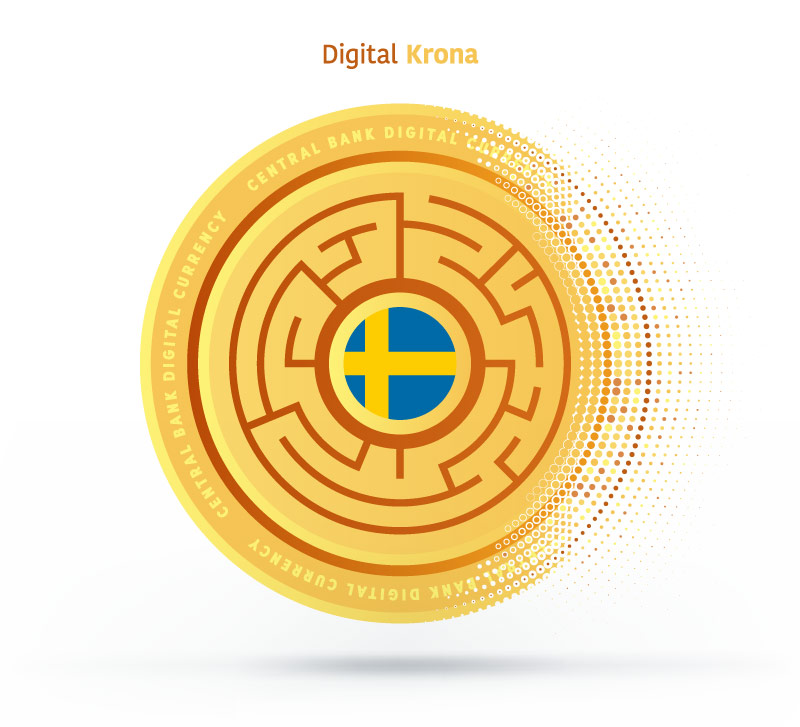
As we hurtle towards cashless economies, central banks around the world are experimenting with their own direct digital currencies. These offer new opportunities for financial inclusion, new levers to control the flow of money within an economy, and new levels of transparency. However, with greater control over and insight into individual transactions comes a heightened threat of overreach from governments. Systemic approaches are needed to overcome barriers to inclusion and mitigate risks to individuals.
What’s New
China’s recent crackdown on cryptocurrencies like Bitcoin and Ether made headlines. What’s less well known is that this crackdown on "non-monetary authorities" coincides with the Chinese government rolling out its own digital currency, the e-CNY, set to be widely used in the Beijing Winter Olympics in 2022. It has already been used for transactions totaling US$9.7 Billion. China is not alone: over 80 countries are currently exploring their own version of a central bank digital currency (CBDC). These are digital payment instruments, denominated in the national currency that is a direct liability of the central bank. In August 2021, 14 countries, including Sweden and South Korea, were piloting CBDCs, and five countries had fully launched them.
The cashless economy is fast emerging, spurred by new forms of money and new digital payment systems. One example is Facebook’s Novi digital wallet, which is being piloted in Guatemala and the US and enables users to send and receive money “instantly, securely, and with no fees.” The wallet currently uses stablecoins and ultimately is likely to include the Facebook-backed Diem currency. If the world migrates to these new forms of digital money, there is a growing risk that central banks may be disintermediated and see their power over monetary policy reduced—hence the race for CBDCs. On the other hand, if CBDCs take off, there’s a risk that private banks lose depositors, potentially driving up interest rates to attract funds. A recent IMF Staff Discussion Note statement concluded that “CBDC could be the next milestone in the evolution of money,” although it also noted that there is “no universal case for CBDC adoption yet.”
CBDCs offer new opportunities for social sustainability. There are opportunities to bank the unbanked through improved identity and “Know Your Customer” (KYC) systems. CBDCs also can help to reduce fraud through heightened transparency and, as a result, to increase trust in transactions and monetary value. CBDCs also offer the possibility of direct payments of universal basic income (UBI), which could include programmable money like tokens, which would expire if not spent. However, a digital cashless society dependent on central bank systems for all transactions poses challenges to privacy and runs the risk of government overreach and surveillance of citizens.
Through CBDCs, authorities have the potential to redesign the payment system from a clean slate to be more interoperable, inclusive, transparent, and efficient—offering economies, particularly those in emerging markets, new avenues for people and businesses to access the formal financial system, as well as new policy options for central banks and governments. However, the design and structure of CBDCs will be critical as to whether they enhance the opportunities while mitigating the risks, which include financial system instability and privacy concerns.”
Design factors like interoperability and inclusivity are key to achieving sustainable outcomes. The Bahamian Sand Dollar, for example, recently entered a partnership with Mastercard to enable the easy conversion of the digital currency to traditional Bahamian dollars, allowing people to pay for goods and services anywhere Mastercard is accepted. Details of the e-CNY, widely considered the most mature pilot of a CBDC, were recently revealed, including that the e-CNY supports increased financial inclusion by not requiring a bank account, enables offline payments to help overcome gaps in digital access, and provides “managed anonymity” by offering unidentified payments below a certain threshold.
Other projects underway signal that CBDCs are being designed with interoperability from the start to improve the efficiency of cross-border digital payments. The Multiple Central Bank Digital Currencies (M-CBDC) Bridge Project is a collaboration between the central banks of Hong Kong, the United Arab Emirates, Thailand, and China to facilitate interoperability in the design of their CBDCs.
The exact format CBDCs take will impact the degree to which they disrupt the financial system and society, and their design is still up for debate in most countries. Design choices include whether CBDCs are retail or wholesale, centralized or decentralized, or interest-bearing or not. As such, CBDCs can range from simply a digitalized version of cash using an encrypted system and intermediaries to fully programmable, interest-bearing money with accounts held directly with the central bank, and multiple variations in between. One key challenge is that research into how different design considerations play out in practice is nascent and therefore limited.
Signals of Change
In September 2020, Mastercard launched a CBDC testing platform to enable central banks to evaluate use cases and test roll-out strategies by simulating a CBDC ecosystem.
China has pressured McDonald’s to expand its pilot of the e-CNY, accepted in 270 branches across Shanghai as of October 2021, ahead of the Beijing Olympics. Nike and Visa are reportedly facing similar pressures.
In the US, the Digital Dollar Project (DDP) is set to launch at least five pilot programs to measure the value and inform the future design of a CBDC, and the Boston Fed and MIT are currently researching possible designs and challenges.
In October 2021, Nigeria began the second largest global pilot of a CBDC with the launch of the e-Naira. The system includes several types of wallets available to users with or without existing bank accounts, based on the different levels of identification users can provide.
Fast Forward to 2025
Now that I have a government-backed digital wallet, I have access to finance to invest in new irrigation systems for my small rubber farm, and I am able to obtain social benefits which are sent directly to my digital account...
The Fast
Forward
BSR Sustainable Futures Lab
Implications for Sustainable Business
The emergence of CBDCs can be seen as a double-edged sword for sustainable business, with potential to expand financial inclusion, enhance transparency, and ease transactions in the financial system, while at the same time posing a major threat to the privacy and protections of individuals from the state. As most CBDCs are still in the exploratory design phase, there is a window now for businesses to advocate for the appropriate design of CBDCs nationally and internationally to protect their employees, supply chain workers, and consumers. They can influence whether or not human rights protection, ease of doing business, and economic prosperity are key tenets of CBDCs and seek to ensure that they improve business’ ability to work with communities and create new, equitable economic opportunities.
CBDCs could expand the tools governments use to distribute money, with new opportunities for direct payments of UBI, aid, or social benefits, such as automation in response to certain conditions or trigger events, from economic downturns to pandemics to natural disasters.
On the other hand, the potential expansion of the central bank’s power creates risks for government overreach and human rights abuses that may impact companies through their direct employees, consumers, and supply chains. For example, while CBDCs could operationalize UBIs, social benefits could be tied to certain social conditions, such as monitored behaviors or social credit system ratings. Direct deposit CBDCs could also enable governments to freeze or confiscate deposits, raising questions for individual rights and levels of trust in government.
Financial Inclusion
One of the key benefits of CBDCs is the potential for strengthening financial inclusion by bringing the unbanked and underbanked into the financial system, increasing access to basic goods, services, and e-commerce, which can expand market opportunities. The unbanked could leapfrog directly into digital currencies, alongside digital identification systems and verification processes. CBDCs could also improve employment opportunities and the availability of personal or small business loans, enabling more diverse employee pools and suppliers. In the financial and insurance sectors, new products and services could be created for and tailored to the newly banked. However, financial inclusion—in the specific form of digital currencies—depends first on digital inclusion.
There are several challenges and practical steps for businesses and financial service providers to consider before they begin paying wages and/or accounts in digital currencies. Businesses can design for equitable access by considering how and where people, especially those who are marginalized and in the informal economy, currently transact. Beyond access, consent is also key. Training and support will be essential to enable individuals to make informed decisions about whether to adopt CBDCs and to promote access for all parties across various points of sale.
Unintended social consequences must be fully explored and mitigated before a company embraces CBDC payments, particularly for vulnerable groups. For example, some early pilots in digital wages have shown many women do not feel comfortable with how transparent their wages are to other members of their household; in extreme cases, it can lead to increased incidences of violence against women. This makes it essential that wage digitalization be gender responsive. As CBDCs are rolled out among employees and supply chain workers, these risks can be minimized through a hyper-localized approach, as the dynamics of gender norms and household finances differ greatly within regions.
Transparency and Data Protection
The enhanced “paper trail” of CBDCs, through the use of digital ledgers that record transactions, will bring new levels of transparency to transactions along the value chain. This could be harnessed to address some of the current challenges in anti-money laundering and KYC (identify verification) processes for companies and to reduce overall fraud and theft. Conversely, these same anti-money laundering mechanisms could also be used to exclude persecuted groups, political activists, and critics of the monetary system.
Depending on their design, CBDCs could grant central banks direct and full access to individual consumer payment data and individual transaction data. Some experts maintain that it is unlikely that CBDCs will be designed to revolutionize financial systems or undermine existing standards of data protection in countries with high levels of accountability. While this is particularly concerning for geographies with limited rule of law and privacy legislation, data protection could also be eroded in countries with strong privacy laws under the auspices of “public good.” For example, access to medical payment data can be justified to inform health care policy. Meanwhile, in more autocratic countries, where accepted standards of data protection are lower, CBDCs pose an immediate risk to both citizen data and to companies accepting payments by CBDC.
CBDCs also heighten the risk of data and cybersecurity breaches for all participating industries, and particularly finance, with more digital touch points between consumers, third-party intermediaries, and the banking system.
Cross-Border Payments
Interoperable CBDCs could reduce current frictions in cross-border payments and enable easier and cheaper supply chain finance. They could also improve market access for small- and medium-sized enterprises in emerging markets that currently lack access to efficient bank transfers and thus support supplier diversity for larger organizations. Greater efficiency in cross-border payments may also reduce dependence on informal transfer systems, which increase the risk of corruption and money laundering in supply chains.
More efficient and transparent cross-border payments could ease remittances for individuals which, if translated into cheaper payments, could have a substantial impact on poverty alleviation and socioeconomic development by placing more wealth in the hands of receiving families, bringing them new opportunities for starting small businesses, or obtaining goods, services, and financial products.
Geopolitics
Global transactions mostly involve the US dollar as the international reserve currency, and the US has significant control over the Society for Worldwide Interbank Financial Telecommunication (SWIFT). These factors position the US Federal Reserve as the de facto overseer of international payments systems, giving heft to US sanctions and laws. However, CBDCs could change this by providing a means for countries to bypass the international payment system, reducing their exposure to US laws and sanctions. Some believe this is a key motivator for China’s cyber yuan. As Monsur Hussain, Head of Research Group FI at Fitch Ratings, observes: “The digital renminbi (RMB) is certainly buttressing the RMB’s reserve currency role and, in time, could weaken the role of the US dollar as the international reserve currency. Current geopolitical tensions could reduce the motivation for establishing universal standards for CBDCs and divergent systems and standards could emerge. In turn, this may curb many of the benefits from using CBDCs for cross-border payments by limiting the reduction of international frictions and transparency standards. We’re already seeing the emergence of two distinct alliances among global central banks working on CBDCs—a developed market cohort with the US and EU, and an emerging market economies group that includes China.”
![]()
Previous issue:
Nature’s Rights Go to Court
![]()
Next issue:
Climate Distress Is Hurting Our Mental Health
































